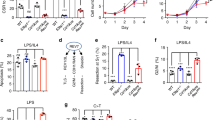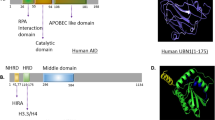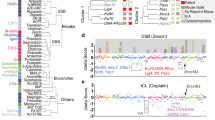Abstract
Activation-induced cytidine deaminase (AID) is required for somatic hypermutation and immunoglobulin class switching in activated B cells. Because AID has no known target-site specificity, there have been efforts to identify non-immunoglobulin AID targets. We show here that AID acts promiscuously, generating widespread DNA double-strand breaks (DSBs), genomic instability and cytotoxicity in B cells with less homologous recombination ability. We demonstrate that the homologous-recombination factor XRCC2 suppressed AID-induced off-target DSBs, promoting B cell survival. Finally, we suggest that aberrations that affect human chromosome 7q36, including XRCC2, correlate with genomic instability in B cell cancers. Our findings demonstrate that AID has promiscuous genomic DSB-inducing activity, identify homologous recombination as a safeguard against off-target AID action, and have implications for genomic instability in B cell cancers.
This is a preview of subscription content, access via your institution
Access options
Subscribe to this journal
Receive 12 print issues and online access
$209.00 per year
only $17.42 per issue
Buy this article
- Purchase on Springer Link
- Instant access to full article PDF
Prices may be subject to local taxes which are calculated during checkout







Similar content being viewed by others
References
Mills, K.D., Ferguson, D.O. & Alt, F.W. The role of DNA breaks in genomic instability and tumorigenesis. Immunol. Rev. 194, 77–95 (2003).
Muramatsu, M., Nagaoka, H., Shinkura, R., Begum, N.A. & Honjo, T. Discovery of activation-induced cytidine deaminase, the engraver of antibody memory. Adv. Immunol. 94, 1–36 (2007).
Durandy, A., Taubenheim, N., Peron, S. & Fischer, A. Pathophysiology of B-cell intrinsic immunoglobulin class switch recombination deficiencies. Adv. Immunol. 94, 275–306 (2007).
Chaudhuri, J. et al. Evolution of the immunoglobulin heavy chain class switch recombination mechanism. Adv. Immunol. 94, 157–214 (2007).
Liu, M. et al. Two levels of protection for the B cell genome during somatic hypermutation. Nature 451, 841–845 (2008).
Robbiani, D.F. et al. AID is required for the chromosomal breaks in c-myc that lead to c-myc/IgH translocations. Cell 135, 1028–1038 (2008).
Liu, M. & Schatz, D.G. Balancing AID and DNA repair during somatic hypermutation. Trends Immunol. 30, 173–181 (2009).
Tsai, A.G. et al. Human chromosomal translocations at CpG sites and a theoretical basis for their lineage and stage specificity. Cell 135, 1130–1142 (2008).
Mahowald, G.K., Baron, J.M. & Sleckman, B.P. Collateral damage from antigen receptor gene diversification. Cell 135, 1009–1012 (2008).
Thacker, J. The role of homologous recombination processes in the repair of severe forms of DNA damage in mammalian cells. Biochimie 81, 77–85 (1999).
Braybrooke, J.P., Spink, K.G., Thacker, J. & Hickson, I.D. The RAD51 family member, RAD51L3, is a DNA-stimulated ATPase that forms a complex with XRCC2. J. Biol. Chem. 275, 29100–29106 (2000).
Deans, B., Griffin, C.S., Maconochie, M. & Thacker, J. Xrcc2 is required for genetic stability, embryonic neurogenesis and viability in mice. EMBO J. 19, 6675–6685 (2000).
Liu, N. XRCC2 is required for the formation of Rad51 foci induced by ionizing radiation and DNA cross-linking agent mitomycin C. J. Biomed. Biotechnol. 2, 106–113 (2002).
Deans, B., Griffin, C.S., O'Regan, P., Jasin, M. & Thacker, J. Homologous recombination deficiency leads to profound genetic instability in cells derived from Xrcc2-knockout mice. Cancer Res. 63, 8181–8187 (2003).
Orii, K.E., Lee, Y., Kondo, N. & McKinnon, P.J. Selective utilization of nonhomologous end-joining and homologous recombination DNA repair pathways during nervous system development. Proc. Natl. Acad. Sci. USA 103, 10017–10022 (2006).
Adam, J., Deans, B. & Thacker, J. A role for Xrcc2 in the early stages of mouse development. DNA Repair (Amst.) 6, 224–234 (2007).
Caddle, L.B., Hasham, M.G., Schott, W.H., Shirley, B.J. & Mills, K.D. Homologous recombination is necessary for normal lymphocyte development. Mol. Cell. Biol. 28, 2295–2303 (2008).
Li, M.J. et al. Rad51 expression and localization in B cells carrying out class switch recombination. Proc. Natl. Acad. Sci. USA 93, 10222–10227 (1996).
Borzillo, G.V., Endo, K. & Tsujimoto, Y. Bcl-2 confers growth and survival advantage to interleukin 7-dependent early pre-B cells which become factor independent by a multistep process in culture. Oncogene 7, 869–876 (1992).
Johnson, R.D., Liu, N. & Jasin, M. Mammalian XRCC2 promotes the repair of DNA double-strand breaks by homologous recombination. Nature 401, 397–399 (1999).
Rogakou, E.P., Pilch, D.R., Orr, A.H., Ivanova, V.S. & Bonner, W.M. DNA double-stranded breaks induce histone H2AX phosphorylation on serine 139. J. Biol. Chem. 273, 5858–5868 (1998).
Nakamura, M. et al. High frequency class switching of an IgM+ B lymphoma clone CH12F3 to IgA+ cells. Int. Immunol. 8, 193–201 (1996).
Thacker, J., Tambini, C.E., Simpson, P.J., Tsui, L.C. & Scherer, S.W. Localization to chromosome 7q36.1 of the human XRCC2 gene, determining sensitivity to DNA-damaging agents. Hum. Mol. Genet. 4, 113–120 (1995).
Dohner, K. et al. Molecular cytogenetic characterization of a critical region in bands 7q35-q36 commonly deleted in malignant myeloid disorders. Blood 92, 4031–4035 (1998).
Simmons, H.M. et al. Cytogenetic and molecular heterogeneity of 7q36/12p13 rearrangements in childhood AML. Leukemia 16, 2408–2416 (2002).
Mao, X. et al. A case of adult T-cell leukaemia/lymphoma characterized by multiplex-fluorescence in situ hybridization, comparative genomic hybridization, fluorescence in situ hybridization and cytogenetics. Br. J. Dermatol. 145, 117–122 (2001).
Chaudhuri, J., Khuong, C. & Alt, F.W. Replication protein A interacts with AID to promote deamination of somatic hypermutation targets. Nature 430, 992–998 (2004).
Thompson, L.H. & Schild, D. Recombinational DNA repair and human disease. Mutat. Res. 509, 49–78 (2002).
Nakano, T. et al. Homologous recombination but not nucleotide excision repair plays a pivotal role in tolerance to DNA-protein crosslinks in mammalian cells. J. Biol. Chem. 284, 27065–27076 (2009).
Couedel, C. et al. Collaboration of homologous recombination and nonhomologous end-joining factors for the survival and integrity of mice and cells. Genes Dev. 18, 1293–1304 (2004).
Ramiro, A. et al. The role of activation induced cytidine deaminase in antibody diversification and chromosome translocations. Adv. Immunol. 94, 75–96 (2007).
Soulas-Sprauel, P. et al. V(D)J and immunoglobulin class switch recombinations: a paradigm to study the regulation of DNA end-joining. Oncogene 26, 7780–7791 (2007).
Danoy, P., Sonoda, E., Lathrop, M., Takeda, S. & Matsuda, F. A naturally occurring genetic variant of human XRCC2 (R188H) confers increased resistance to cisplatin-induced DNA damage. Biochem. Biophys. Res. Commun. 352, 763–768 (2007).
Sale, J.E., Calandrini, D.M., Takata, M., Takeda, S. & Neuberger, M.S. Ablation of XRCC2/3 transforms immunoglobulin V gene conversion into somatic hypermutation. Nature 412, 921–926 (2001).
Zaheen, A. et al. AID constrains germinal center size by rendering B cells susceptible to apoptosis. Blood 114, 547–554 (2009).
Caddle, L.B., Hasham, M.G., Schott, W.H., Shirley, B.J. & Mills, K.D. Homologous recombination is necessary for normal lymphocyte development. Mol. Cell. Biol. 28, 2295–2303 (2008).
Donehower, L.A. et al. Mice deficient for p53 are developmentally normal but susceptible to spontaneous tumours. Nature 356, 215–221 (1992).
Muramatsu, M. et al. Class switch recombination and hypermutation require activation-induced cytidine deaminase (AID), a potential RNA editing enzyme. Cell 102, 553–563 (2000).
Nakamura, M. et al. High frequency class switching of an IgM+ B lymphoma clone CH12F3 to IgA+ cells. Int. Immunol. 8, 193–201 (1996).
Hasham, M.G. & Tsygankov, A.Y. Tip, an Lck-interacting protein of Herpesvirus saimiri, causes Fas- and Lck-dependent apoptosis of T lymphocytes. Virology 320, 313–329 (2004).
Deans, B., Griffin, C.S., Maconochie, M. & Thacker, J. Xrcc2 is required for genetic stability, embryonic neurogenesis and viability in mice. EMBO J. 19, 6675–6685 (2000).
Woo, Y. et al. The nonhomologous end joining factor Artemis suppresses multi-tissue tumor formation and prevents loss of heterozygosity. Oncogene 26, 6010–6020 (2007).
Wright, S.M. et al. Complex oncogenic translocations with gene amplification are initiated by specific DNA breaks in lymphocytes. Cancer Res. 69, 4454–4460 (2009).
Acknowledgements
We thank T. Honjo (Kyoto Univesity), R. Maser and S. LaSalle (The Jackson Laboratory) and A.Y. Tsygankov (Temple University School of Medicine) for reagents and mice; C. Boboila, B. Schwer and F.W. Alt (Children's Hospital, Boston) and J. Chaudhuri (Memorial Sloan-Kettering Cancer Center) for reagents and technical assistance; and the Jackson Laboratory Gene Expression, Molecular Biology and Flow Cytometry Services for technical support. Supported by the US National Institutes of Health (R01CA138646, P20RR018789-06, T32DK07449-26 and P30CA034196) and the Maine Cancer Foundation.
Author information
Authors and Affiliations
Contributions
M.G.H. designed and did experiments and wrote the manuscript; J.A., E.C., N.M.D., J.M. and K.J.S. did experiments and contributed data; Y.H., B.L.K. and R.Y.W. contributed data; and K.D.M. designed experiments and wrote the manuscript.
Corresponding author
Ethics declarations
Competing interests
The authors declare no competing financial interests.
Supplementary information
Supplementary Text and Figures
Supplementary Figures 1–17 (PDF 3097 kb)
Rights and permissions
About this article
Cite this article
Hasham, M., Donghia, N., Coffey, E. et al. Widespread genomic breaks generated by activation-induced cytidine deaminase are prevented by homologous recombination. Nat Immunol 11, 820–826 (2010). https://doi.org/10.1038/ni.1909
Received:
Accepted:
Published:
Issue Date:
DOI: https://doi.org/10.1038/ni.1909
This article is cited by
-
A new wave of innovations within the DNA damage response
Signal Transduction and Targeted Therapy (2023)
-
Genetic Risk Variants for Class Switching Recombination Defects in Ataxia-Telangiectasia Patients
Journal of Clinical Immunology (2022)
-
A licensing step links AID to transcription elongation for mutagenesis in B cells
Nature Communications (2018)
-
AIMP3 Deletion Induces Acute Radiation Syndrome-like Phenotype in Mice
Scientific Reports (2018)
-
RECQ helicases are deregulated in hematological malignancies in association with a prognostic value
Biomarker Research (2016)



